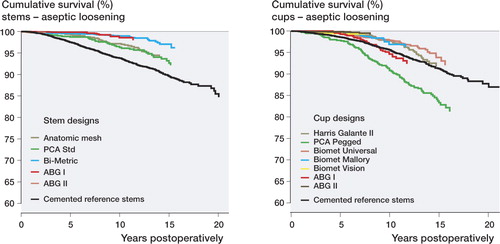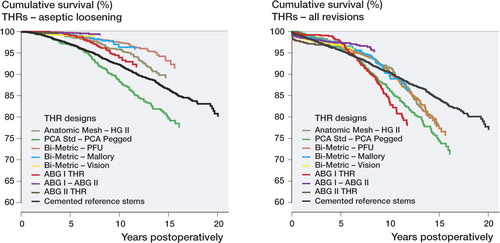Figures & data
Table 1. Demographic data of the implants analyzed
Table 2. Material, surface, design features, and manufacturer of the implants. For abbreviations, see
Table 3. Reasons for revision of the 8 most common cementless brands and the cemented reference designs. Percentage in parentheses. For prosthesis types, see
Figure 1. Cox-adjusted survival curves for 19,859 stems and 19,859 cups in patients aged 55 years or older with stem designs (panel A) or cup designs (panel B) as the strata factors. The endpoint was defined as stem (A) or cup (B) revision due to aseptic loosening. Adjustment was made for age and sex. For an explanation of abbreviations, see .

Table 4. Survival of cementless stems and the cemented reference group. Endpoint was defined as revision due to aseptic loosening of the stem. 7-, 10-, and 15-year survival rates were obtained from the Kaplan-Meier analysis. For prosthesis types, see
Table 5. Survival of cementless cups and the cemented reference group. Endpoint was defined as revision due to aseptic loosening of the cup. 7-, 10-, and 15-year survival rates were obtained from the Kaplan-Meier analysis. For abbreviations, see
Figure 2. Cox-adjusted survival curves for 19,859 total hip replacements in patients aged 55 years or older with total hip replacement design as the strata factor. The endpoint was defined as revision of the stem and/or the cup due to aseptic loosening (panel A) or as revision for any reason (B). Adjustment was made for age and sex. For an explanation of abbreviations, see .

Table 6. Survival of cementless total hip replacements and the cemented reference group. Endpoint was defined as revision due to aseptic loosening of the cup and/or the stem. 7-, 10-, and 15-year survival rates were obtained from the Kaplan-Meier analysis. For abbreviations, see
Table 7. Survival of cementless total hip replacements and the cemented reference group. Endpoint was defined as revision of the cup and/or the stem for any reason. 7-, 10-, and 15-year survival rates were obtained from the Kaplan-Meier analysis. For an explanation of abbreviations, see